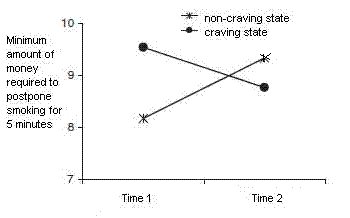ASHES, Vol. 4 (12) – Underestimating the burning desire to smoke
For cigarette smokers, the experience of craving is a powerful motivator. When people are craving cigarettes, they think about more positive aspects of smoking, they think their craving will intensify over time (even though it doesn’t), and they experience a slowing down of time (a sense of “extended now”) (as reviewed by Sayette et al., 2008). This all contributes to a visceral desire to smoke. However, when smokers are not in a craving state, they might have trouble estimating how powerful the urge to smoke will be during future craving episodes. In other domains, underestimating the extent to which visceral factors will impact future behavior is known as the “cold-to-hot empathy gap” (Loewenstein, 1996) This week’s ASHES reviews a study that documents the role of the cold-to-hot empathy gap in cigarette craving (Sayette et al., 2008).
Participants:
• Participants were male and female adult cigarette smokers (N = 98) recruited from newspaper advertisements not currently interested in quitting but willing to abstain from smoking for up to 2 days.
Measures:
• At Time 1, participants predicted the minimum amount of money they would require to postpone smoking for 5 minutes at Time 2, when they would be craving a cigarette.
• Participants made this prediction either while in a craving state (i.e., hot) or a non-craving state (i.e., cold). Those who were randomly assigned to the craving state had abstained from smoking for at least the past 12 hours and were exposed to smoking cues while making the prediction. Those in a non-craving state had smoked as they normally would and were not exposed to smoking cues while making the prediction. The experimental groups did not differ in age, ethnicity, gender, martial status, number of cigarettes smoked per day, or nicotine dependence.
• At Time 2, all participants had abstained from smoking for at least the past 12 hours. This was confirmed by measuring participants’ carbon monoxide levels. While holding a lit cigarette, participants were asked to indicate the minimum amount of money they would require to delay smoking for 5 minutes “right now.” Investigators did not report the study attrition rates.
• Then, all participants were allowed to smoke immediately.
• The main dependent measures were the amounts provided at Time 1 and Time 2.
• The researchers hypothesized that participants who made their predictions while in a non-craving state would underestimate how much money they would require to postpone smoking at Time 2, but that no such difference would be found among those who made their predictions in a craving state.
Results:
• A Group (craving, non-craving) by Time (1, 2) ANOVA (with repeated measures on the second factor) was significant, F (1, 72) = 7.83, p<.01.
• Participants in the non-craving group showed a significant increase in the amount required to postpone smoking from Time 1 (M = $8.18, SD = 5.27) to Time 2 (M = $9.33, SD = 5.34), p < .05. This result corresponds to a small-to-medium effect size. No such increase was found for participants in the craving group (Time 1 M = $9.53, SD = 6.99; Time 2 M = $8.77, SD = 6.05).

Figure. Minimum amount of money required to postpone smoking for 5 minutes, as a function of Group during initial prediction and Time. Adapted from Sayette et al. (2008). Click image to enlarge.
Limitations:
• The researchers are making the assumption that the minimum amount of money required to postpone smoking for 5 minutes is a valid proxy for how strongly participants want to smoke. It is unclear whether this assumption is valid. However, participants also indicated their urge to smoke and the results using this measure were consistent with the monetary prediction results. In future research, it would be interesting to supplement these self-reports with confirmatory physiological indicators reflecting the visceral urge to smoke.
• Investigators artificially created the craving state in this study. It is unclear to what extent this state is similar to the cravings smokers experience in everyday life, such as the craving brought on by stress or habits.
• It is not clear whether these results might generalize to other types of craving.
Conclusions:
Smokers who were in a non-craving state failed to anticipate how powerful the urge to smoke would be when they were craving cigarettes. This result has at least two implications. First, non-smokers, who are always in a non-craving state, might not appreciate how difficult it would be for them to quit if they were to become nicotine dependent. This tendency to underestimate the power of craving might hamper efforts to prevent young people from smoking in the first place. Second, many times smokers decide to quit while they are in a non-craving state. Because smokers’ underestimate of how difficult it will be to abstain in the future, we can better understand why they so often fail to quit. This brings up an interesting question: should clinicians advise smokers to wait until they are in a craving state before deciding whether to try quitting? If so, they might more accurately predict how difficult it will be to abstain in the future and they might be more likely to avoid high-risk situations that increase the urge to smoke. On the other hand, knowing how difficult it will be to quit smoking might make them less likely to attempt quitting.
–Heather Gray
References:
What do you think? Please use the comment link below to provide feedback on this article.